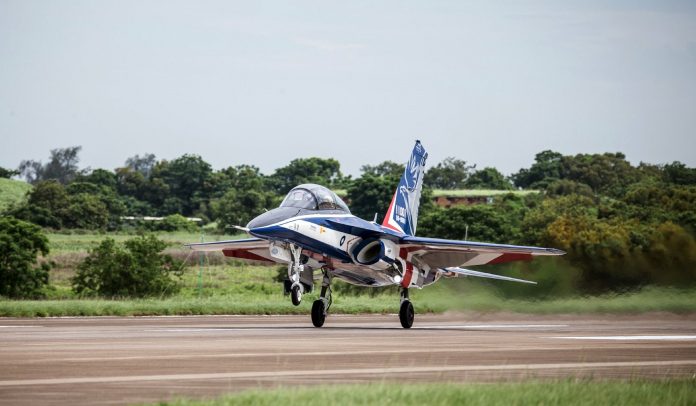The Republic of China Air Force (RoCAF) has received the first Aerospace Industrial Development Corporation (AIDC) T-5 Yung Yin (Brave Eagle) advanced jet trainer (AJT).
The RoCAF revealed on its official social media account on 28 November that the twin-engine aircraft took off from the Ching Chuan Kang Air Base in Taichung, where AIDC’s facilities are located and landed at Zhihang Air Base in Taitung where a handover ceremony was held.
The new aircraft, which was assigned serial number ‘11003’, is the first-production example. The second production aircraft is expected to be delivered by the end of 2021. Both aircraft will be used for testing by the RoCAF, complement the two prototypes already being tested by the service.
Serial production is expected to commence from March 2023.
The first prototype, A1 (serial number 11001), was developed in partnership with the National Chung-Shan Institute of Science and Technology (NCSIST) and conducted its first flight in June 2020, while the second flew in late December 2020.
The US$2.2 billion contract for the T-5’s development was awarded to AIDC/NCSIST on 7 February 2017, with the aim of producing up to 66 aircraft by 2026 to replace the ageing AIDC AT-3 trainers and license-built Northrop F-5E/F Tiger IIs fighter/trainers that have been in use since the 1980s and 1970s.
Previously identified as the XAT-5 Lán Què (Blue Magpie) during its early development, the T-5 Brave Eagle draws heavily on AIDC’s experience in developing and manufacturing the in-service F-CK-1 Ching-Kuo Indigenous Defence Fighter (IDF), albeit differentiated by as much as 80% worth of new content despite the physical resemblance.
Other enhancements include a revised and strengthened airframe that has been optimised for low-speed flight stability, increased internal fuel capacity, and a redesigned undercarriage for improved landing and taxiing operations.
Like the IDF, the T-5 will be powered a pair of locally manufactured F124-200TW turbofan engines supplied by the International Turbine Engine Company (ITEC), a joint venture between AIDC and Honeywell Aerospace.
Taoyuan-based Pyras Technology has reportedly been contracted to supply the radar and communications antenna, while the aircraft’s equipment fit also includes a customised BAE Systems cockpit display system as well as Martin Baker ejection seats.
NCSIST will also supply up to 26 ground-based training systems (GBTS), including 16 mission planning systems, three basic flight simulators, a full-function flight simulator, a ground-based real-time monitoring system, and a flight training management system.
by Jr Ng













